
LEFKANDI-XEROPOLIS 2003 SEASON
West Sector
The structural situation in the West Sector is far more complicated. This region is flatter and higher – and so more stable, with less dramatic effects suffered from erosion.
 |
Planning
architectural features |
The north portion also benefited from the existence of a slope of some 50 cm down to a lower region at the edge of the tell here. This hollow or lower zone permitted the growth and preservation of a greater depth of the soil in the EIA period.
Starting at this northern end, one structure was found close to the area where in the earlier excavations the Moulds Deposit and the SPG Pit were found. This is part of an apsidal structure. A segment of the apse itself has been revealed. It is some 3 m long by at least 4 m wide. Because of the need for further excavation, its orientation is uncertain, but it probably has a NW/SE long axis – in which case it would be differently aligned from a counterpart in the nearby compound to the west excavated by Mervyn Popham. The building has remnants of a lime-based ‘floor’ within, whilst pebble spreads mark the exterior ground surface to the east and south. A date of SPG II/III and LG is given by accompanying sherds.
Not far removed in time (in LG II) and space come a pair of linked walls: one linear and the other a half-circle attached to the east side of the first. These lie south and west of the apsidal structure, and they are set slightly higher thus, in order to build them, would have required the whole or partial demolition of the earlier house. The semi-circular feature is some 3 m across with the N/S linear part traced over 2 m.
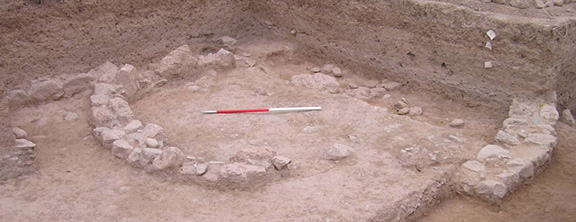 |
| West
Sector: Late Geometric Apsidal and Circular Structures |
Elsewhere to the east the slope up to the south had been tackled more directly and originally earlier by means of inserting an E/W series of retaining walls to prevent the soil slipping. The first such wall (Wall 28), which is substantial, dates to LH IIIC at the latest. It protects a house which was excavated in the 1960s in Trial N. As well as this deliberate construction, other nearby areas was packed with dumped stones in a more irregular pattern, a process which appears to have continued into the EIA. The eventual effect of this, plus the presence of a slighter wall (Wall 30) abutting the earlier wall to its north – an EIA creation – was to fashion a short ramp by which access was feasible from the lower north to the higher southern regions. The existence of traffic up and down this passage is indicated in the laying down of pebble surfaces on grey soils: several were excavated. A similar pebbled surface runs up to and under the north-west corner of the rectangular Building I; it is also utilized to provide a decent entrance surface at the door in its west wall.
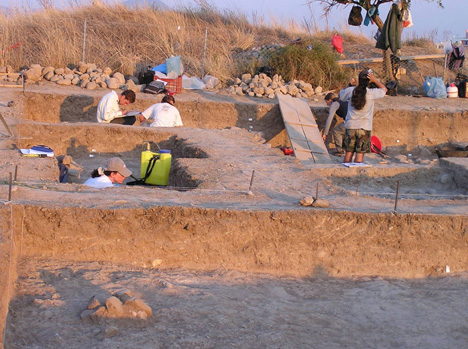 |
In the middle of the West Sector is Building I – the date of which appears to be LG or later. Unfortunately, this rectangular structure has been badly damaged by the modern plough. Its north side is preserved as are part of its west with a door and the hint of a return of its east wall. The southern wall is lost, unless a wall found there is part of it. These walls give a structure of 5 m E/W by at least 3 (and probably 4) N/S. Careful excavation of the interior of the building failed to produce clear traces of floor, or evidence of purpose or date. The only indication comes from the presence of part of a ‘capped’ pithos at 10–15 cm below the wall-bases. Such vessels are usually assigned to the very end of the Late Geometric or to the Archaic period.
South of Building I, the postulated
stratigraphic integrity of the site breaks down. This is partly due to
modern plough damage, but also reflects the fact that in this area the
EIA presence seems to have involved repeated and extensive removal of
earlier structures. At the present stage of study it would be premature
to try to over-interpret this. It is worth pointing out, however, a few
specific areas over the south part of the excavation where EIA activities
have been noticed:
(1) Wall 21: potentially reused for Building I as its south wall, but
clearly earlier, it sits directly on local mud-brick-derived material
and thus is potentially Mycenaean or very early EIA. (Building I has some
10 cm of EIA material between it and the same mud-brick soils and so is
later.) Of particular interest is the structure to its south. A basic
‘box’ (measuring 60–70 cm square and 30 cm deep) was
cut down into the mud-brick soils and lined with stone and clay slabs
set vertically. It contained a grey, ashy fill but no obvious signs of
exposure to heat (as in a hearth).
(2) Wall 22 is curved and could have been part of another apsidal building,
aligned N/S. It is positioned without any apparent regard for existing
Mycenaean walls and earlier usage of space in the area. However, it is
also adjacent to and higher than a region from which came a good deal
of E/MPG sherd material.
West Sector: Preliminary Pottery Report 2003
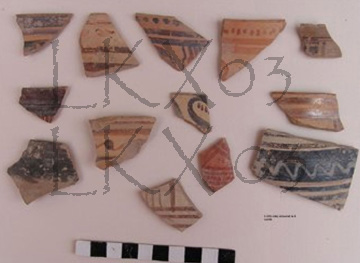 |
1. Late Geometric pottery was found associated with the complex of apsidal and the circular structures excavated in the north part of the Sector. In particular the apsidal Wall 45 is associated with SPG III and Late Geometric pottery. Wall 44 is associated with Late Geometric II pottery which includes examples of bichrome skyphoi.
2. Building I: a pithos was found 10–15 cm below the wall-bases
of the building. This is a type of pithos with a distinctive ‘capped’
bottom. Similar pithoi have been found in Corinth and dated to the Late
Protocorithian period (late seventh century BC). Another parallel from
Zagora is dated to Late Geometric II. This comparative data confirms that
Building I was used at the very end of the LG or even during the Archaic
period.
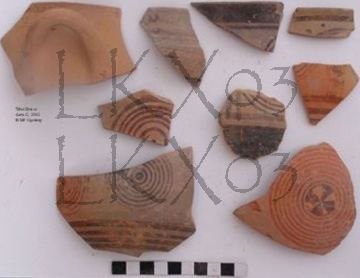 |
3. PG Apsidal Wall 22: important Early PG and Middle PG pottery associated with the wall establish the use of the area during this period. MPG is also the date of the funerary building at Toumba. Pottery from the filling-in of the Toumba building finds close parallels with the pottery found in Xeropolis this year. Illustrated here are some examples of circle skyphoi.
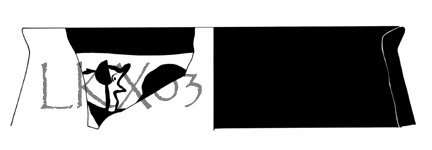 |
4. LH IIIC pottery from the south area of the sector: interesting examples of Late Helladic IIIC pottery of Lefkandi phase 2b and phase 3 were found in this area including the rim of a crater with figured decoration.This complements the pieces with warrior scenes known from the earlier excavations.
 |
5. Late Geometric pottery from the south area of the sector: some interesting pieces come from this area including a sherd from the handle of a cup with graffito.
Home > New Excavations >2003 Season > 2003 Season West Sector >2003 Season East Sector